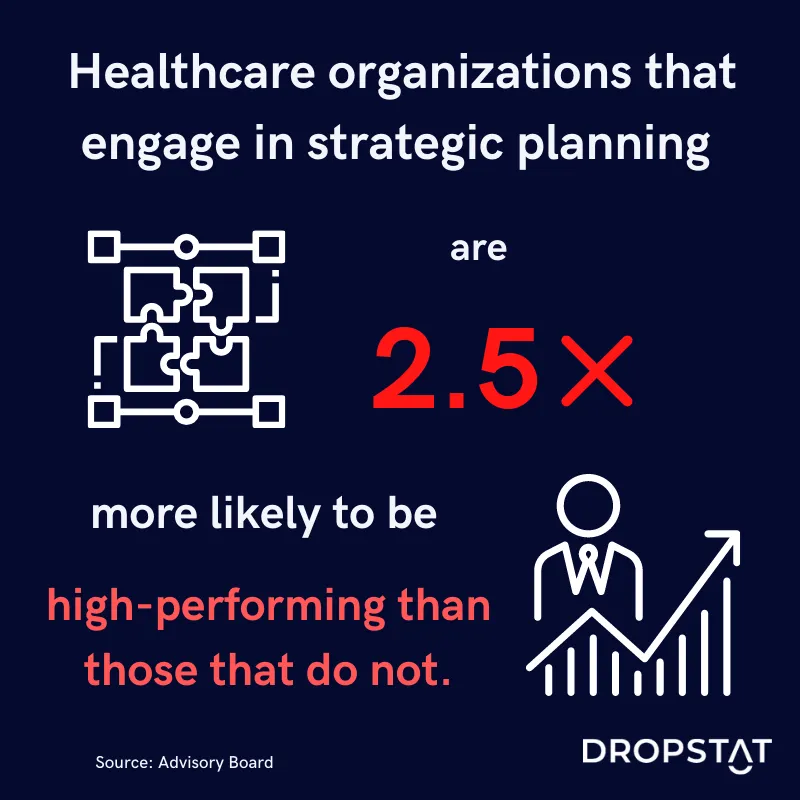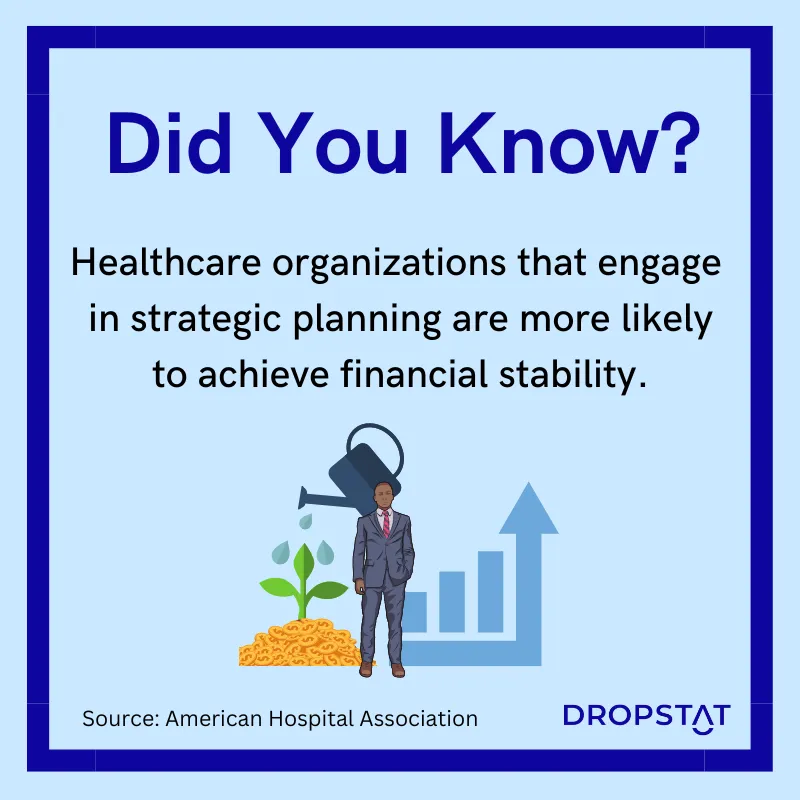Benefits of strategic planning in healthcare organizations
The strategic planning process is essential to ensure that your healthcare facility has clearly defined goals and that the institution is ready for the constant changes in healthcare, which ultimately increases the facility’s profit margins. Senior leadership within healthcare settings should utilize strategic plans to decide which goals and objectives should be prioritized. This practice gives your institution the ability to analyze its processes and key performance indicators. Here are some of the key benefits of strategic planning in healthcare:
- Identify a concrete organizational mission and overarching vision
- Prioritize the factors that pose the largest threats to your goals
- Improve care coordination
- Increase facility efficiency through better resource allocation
- Prepare your healthcare organization to adapt to change
- Support more informed decision-making
Develop an organizational mission and vision
When your healthcare staff has a clear understanding of the mission and vision of the facility, it becomes easier to align care practices and team efforts with the long-term objectives. Taking part in strategic planning helps strengthen your organization’s mission by establishing attainable goals that meet stakeholders’ expectations.
Determine the greatest threats to achieving your goals
Although strategic healthcare planning is a key component of goal setting, it also encourages deeper analysis of your operations and the threats that may interfere with the long-term objectives. Assessing the performance of your institution allows leadership to prioritize the highest risks and develop plans that acknowledge potential setbacks.

Promote better care coordination.
Implementing strategies that consider your clinical staff’s point of view guarantees that the approaches to improving your facility are evidence-based. Gaining insight into the common struggles of your staff helps construct a better understanding of critical issues. In turn, this knowledge can help create processes that are targeted at improving care coordination, which increases patient satisfaction and improves health outcomes.
Improve facility efficiency
By analyzing your facility’s current procedures and determining inefficiencies, institutions are better positioned to reduce waste and overuse of services and resources. This practice can also reduce costs by improving resource allocation based on patient and staff needs within each department.
Increase organizational adaptability
Preparing your organization to achieve set objectives requires your management team to determine current and future obstacles. Generating action plans with these challenges in mind helps ensure that your goals are attainable and prevents resources from being wasted on efforts that do not have the potential for successful execution. Ultimately, the ability to adapt and plan for barriers enables your healthcare organization to implement pragmatic plans.
Support more informed decision-making.
Deciding which healthcare policies and plans align with your organization’s mission is an essential element of strategic planning. This provides a general guide for healthcare executives to use when allocating resources and contributes to more informed staff decision-making, which positions your facility to be as competitive as possible.

The best strategic planning models in healthcare
There are numerous strategic planning models that can be used to create a long-term plan for your organization. However, the ideal strategy or model should be determined by considering the unique needs of your facility’s staff and patients as well as the current healthcare environment. Some common strategic planning models include:
- SWOT Analysis
- Balanced Scorecard
- Lean Six Sigma
- Value-Based Healthcare
The SWOT Analysis
An organization’s competitive position can be revealed by evaluating its strengths, weaknesses, opportunities, and threats (SWOT). This method assesses internal and external factors that impact your healthcare facility in order to generate a holistic understanding of your organization before taking action.
Balanced Scorecard
The balanced scorecard technique evaluates an institution’s internal processes by analyzing four components, including learning and growth, financial data, internal analysis, and customer perspectives. This model helps healthcare institutions measure and track their progress toward their goals and determine how the different objectives and organizational factors are intertwined.
Lean Six Sigma
Lean Six Sigma utilizes five methods to reduce wasted resources which in turn improves processes and efficiency. These five methods include defining, measuring, analyzing, improving, and controlling, which are carried out through team efforts to improve facility performance.
Value-Based Healthcare
This strategic planning framework prioritizes reducing the per capita cost of healthcare while delivering the highest quality care and instituting patient safety protocols. This foundation can be used to redirect organizational efforts from prioritizing the quantity of care delivered to the quality and outcomes of the care.

The stages of strategic planning in healthcare
- Define your vision: Regardless of which aspect of your facility is the focal point of your improvement initiative, it is imperative that your organization has an overarching objective before generating a strategic plan.
- Assess your current position: Conducting an environmental and internal assessment of your healthcare institution allows your strategic planning team to set goals that are manageable and focused.
- Determine objectives and priorities: With a vision and understanding of your facility’s current position, you are prepared to specify your organization’s distinct priorities and designate the tasks that support the agenda.
- Develop a strategic plan and responsibilities: Within this stage of strategic planning, your team will identify the methods and mechanisms that will be used to achieve the goals. These methods should consider the current position of the institution as well as its resources and capacity to carry out these plans.
- Implement the strategic plan: Executing the plan requires that your institution has a detailed index of the ideal timeline, different tasks, and resources that are needed to successfully carry out the plan and support the organization’s mission and vision.
- Measure and evaluate results: After implementing your strategy, it is crucial to evaluate progress and search for any faults in your strategy that may hinder continuous improvement. Determining the ways in which you will track progress and revise the outlined plan to ensure that it functions properly within the dynamic healthcare environment.
How Dropstat supports strategic planning initiatives
One of the key prerequisites of strategic planning in healthcare is understanding your organization’s weaknesses. Dropstat provides healthcare facilities with specific data that alerts healthcare leaders about recurring staffing challenges within their facility. For example, Dropstat tracks overtime, bonus spending, and agency use which can illuminate shifts that regularly experience short staffing. These situations may lead to decreased patient satisfaction, care quality, and safety while increasing burnout among nursing staff. However, using these metrics from Dropstat will aid your strategic planning practices and can help produce more comprehensive action plans.
Schedule a demo now and start using Dropstat’s advanced analytics to help improve your strategic planning process.







